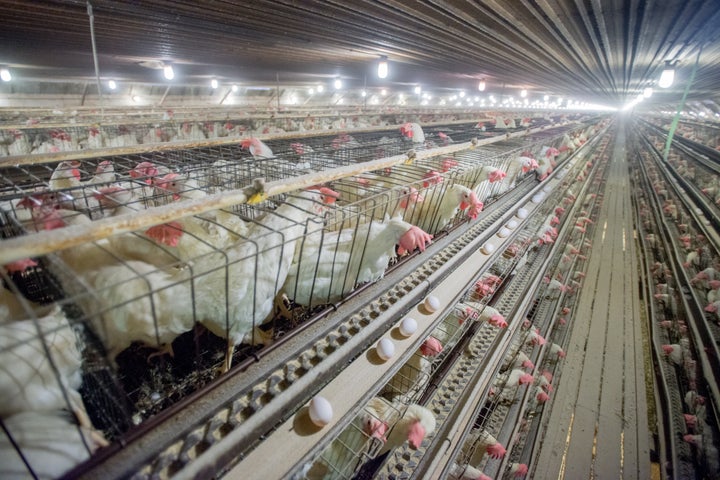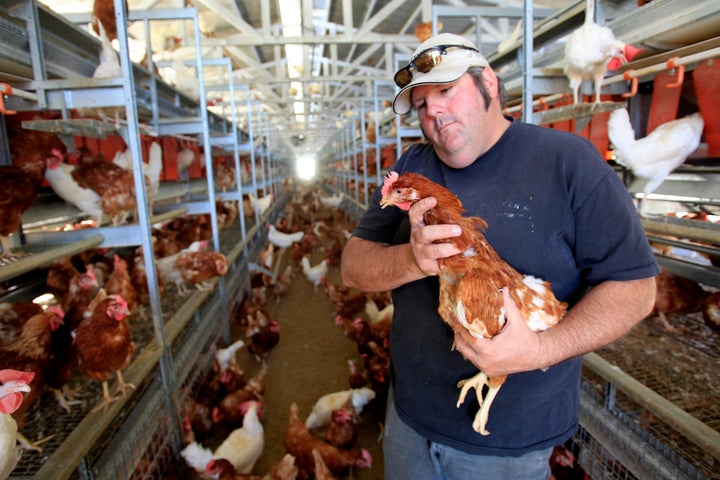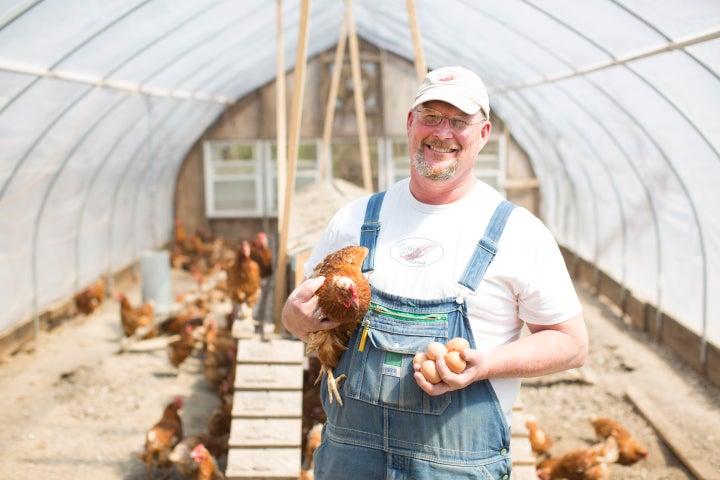The egg shelves at the supermarket can be tricky to navigate, since you have to choose between labels and claims like “free-range,” “cage-free” and “pasture-raised” (oh my). And then considering organic designations and various welfare certifications can be overwhelming, leaving you to just go with the cheapest option.
While the demand for cage-free eggs is on the rise, conventional (read: caged) hens still supply the vast majority of eggs in the U.S., with 81.6% (or 275.4 million laying hens) housed in conventional cage environments as of March 2019.
That statistic may come as a surprise, as it’s rare that a producer will proudly proclaim that their eggs come from caged chickens. Terms like “farm fresh,” “natural” or “vegetarian” may be used to hide caged eggs in plain sight, as they have nothing to do with how the hens are raised. (You could pick up some “vegetarian” eggs from the supermarket without realizing you bought a carton of caged eggs.)
Which eggs you should buy depends on what you prioritize in your food sources — but the experts HuffPost consulted all agreed that as far as animal welfare is concerned, caged is a no-go.
To Josh Balk, vice president of farm animal protection at the Humane Society of the United States, the differences between cage-free, free-range, pasture-raised and organic are minute compared to the vast difference in hens’ quality of life between any of these options and caged. He said that if you don’t see any of those four labels on a carton, you’re looking at caged eggs, “one of the cruelest products ever offered in our food system.”
For Jim Hauskey, director of marketing at Happy Egg Co., free-range is the base standard for how hens need to be treated.
To help you make better decisions about buying eggs and more confidently decode their cartons, we’ve defined common terms you may encounter below.

Caged
Caged eggs come from hens that spend their egg-laying lives in a cage, the majority of which are so small that the hens can’t spread their wings. The United Egg Producers’ guidelines for cage production systems list a minimum of 67 square inches per hen, which is smaller than a standard 8.5 inch by 11 inch sheet of paper.
“They’re unable to do very basic behaviors,” Balk told HuffPost. “They can’t spread their wings, stand on solid ground, perch, scratch, dust bathe, or lay eggs in a nesting area. These are critical behaviors that chickens have to be able to engage in in order to have some type of decent life and they can’t engage in any of them inside one of these cages.”

Cage-free
As the label suggests, cage-free eggs come from hens that don’t live their lives confined to cages. According to Department of Agriculture guidelines, eggs labeled cage-free “must be produced by hens housed in a building, room or enclosed area that allows for unlimited access to food, water and provides the freedom to roam within the area during the laying cycle.”
It’s important to note that this definition doesn’t specify how much space each hen has or whether they ever see the outdoors. Cage-free is a broad term that encompasses indoor housing systems; systems that offer access to the outdoors; and systems that are outdoor-centric. American Humane Certified welfare standards stipulate that “all hens must have sufficient freedom of movement to be able to stand normally, turn around and stretch their wings without difficulty. They must have sufficient space to be able to perch or sit quietly without repeated disturbance.” Additionally, these hens must have access to a well-maintained litter or scratch area where they can dust bathe, and nest boxes with curtains or dividers for privacy.

Free-range
Free-range eggs come from hens that have “continuous access to the outdoors during their laying cycle,” according to the USDA, which further stipulates that “the outdoor area may be fenced and/or covered with netting-like material.” This broad definition encompasses everything from just a few small doors leading to an unappealing screened-in porch to barns with multiple large openings and several acres for hens to forage, perch and exhibit other typical hen behaviors.
Like cage-free, additional welfare certifications can offer enhanced insights on what free-range actually means for the life of egg-laying hens. Happy Egg Co., for example, is certified by American Humane, a distinction that means more than just additional space for hens to roam (1 acre of outdoor space for every 2,000 hens; 21.8 square feet per bird).
“There’s 200 or more other standards that our farms have to follow to make sure the hens are treated right,” said Hauskey from Happy Egg Co. “Everywhere from the air quality to water quality and the amount of water, the space and number of doors to the feed quality and source.”
Pasture-raised
Pasture-raised, which is a relatively new term used to describe eggs, is not explicitly defined by the USDA. If you see pasture-raised on an egg carton, it’s important to look for additional certifications from independent agencies like Certified Humane and American Humane, which have outlined specific definitions for the term.
Certified Humane pasture-raised eggs require 2.5 acres for every 1,000 birds (108 square feet per bird). According to its standards, “The hens must be outdoors year-round, with mobile or fixed housing where the hens can go inside at night to protect themselves from predators, or for up to two weeks out of the year due only to very inclement weather.”
Organic
In order to be considered organic by the USDA, a food item must meet certain standards. These include year-round access to the outdoors (with temporary confinement permitted for environmental or health reasons) and 100% organic feed. In other words, organic eggs come from free-range hens that are fed an organic diet free from synthetic pesticides.
Vegetarian
This term is confusing because chickens are omnivores by nature. Vegetarian indicates the feed given to the chickens did not contain any meat or animal byproducts. At farms where chickens are allowed to roam the outdoors, hens have the opportunity to supplement their feed by foraging for worms and insects. The label “vegetarian feed” can appear on product packaging for these hens’ eggs in this instance, as long as the feed they’re given is meat-free.
Regarding the free-range eggs sold by Happy Egg Co. (where hens are fed an all-natural, vegetarian feed and allowed to forage during the day), Hauskey said, “People can feel good about how the hens are treated, and knowing that some of their diet comes from the range adds a little bit of authenticity and naturalness to what comes out in the end, which is a beautiful egg.”
Omega-3 enriched
Like vegetarian, “omega-3 enriched” is a label that doesn’t relate to hen welfare. It typically means some flax seed was mixed into their feed, leading to higher omega-3 fatty acid levels in the resulting egg.
